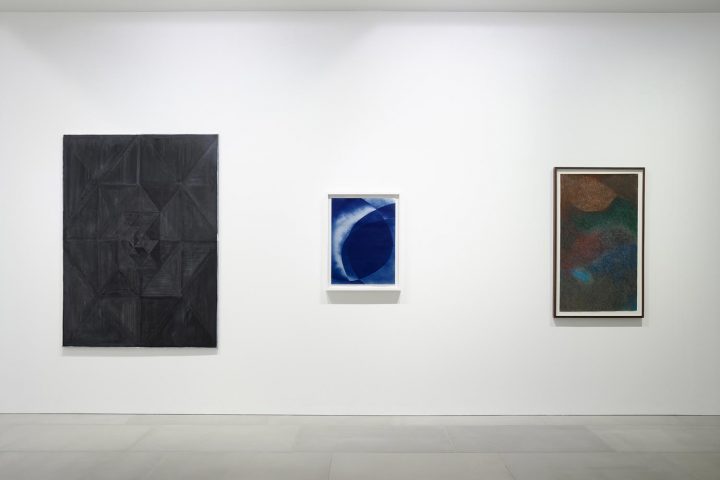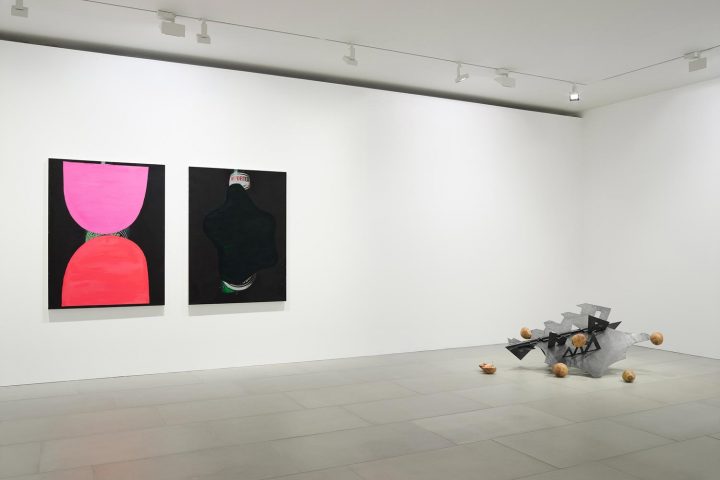Convened to accompany Bosco Sodi’s concurrent exhibition, “Heavens and the Earth” — also at Blain Southern — this small group show brings together work by nine Mexican artists, unified by their shared contribution to the Fundación Casa Wabi: the artist-led community set up by Sodi in Oaxaca in 2014. Curated by Sodi alongside Alberto Rios, former chief curator at Casa Wabi, it is difficult not to make comparisons between Sodi’s own move toward monochrome, witnessed here in a majestic series of painted processes in black and white, and that apparent in the works of his compatriots. Performance artist Galia Eibenschutz shares Sodi’s embrace of transience and chance in her praxis. Her triptych of “instants” conjures the indexicality of dance through white chalk effusions on blackboard canvas, each produced during the same 2017 performance. It’s aptly juxtaposed against the ceaseless whirring of Tania Candiani’s Sobra el tiempo (On time) (2008–15): an inventory of 240 unbranded alarm clocks on white wooden shelving. Just as Sodi makes explicit his debt to the Japanese aesthetic philosophy of wabi-sabi through cultivated impermanence and imperfection, so Candiani calls attention to time’s deteriorative effect on technology through minute hands that loop crazily at unexpected intervals. Benjamin Torres extends this subversive serialism through a pair of digitally printed Heineken bottles painted over in obtrusive pink, red, and black acrylic. An overt reference to the foreign buyout of Mexican brewer FEMSA, owner of Dos Equis and Sol, by Heineken NV, Torres’s critique of free market capitalism lays bare the appropriation and inflection of authentic Mexican identity by neoliberal economic policy. A trio of other artists seeks to excavate a Mexican culture unmediated by mass media. Francisco Muñoz’s Hombre Murciélago (Bat-Man) (2018) overlays the image of an early totem with an absurd collage of fashion plot paper, while Cristóbal Gracia’s jagged floor sculpture of cut iron and coconuts (Erizo Acapulqueño, 2017) punctures the Hollywood vision of a postcolonial Acapulco. In its hanging mass of gray plaster and pig leather, Tomás Díaz Cedeño’s Camina (2018) somewhat hybridizes the other two, encapsulating a vision rooted in early Mexican history — an archaeology inspired by Sodi.
21 May 2019, 12:53 pm CET
Approaching Abstraction Blain Southern / London by Alex Estorick
by Alex Estorick May 21, 2019Pace expands in London
Pace, the New York based international gallery, is due to open a 9,000 square foot space in Mayfair, London this…
Signal Failure Pace / London

How does one defy the increasingly ubiquitous presence of electronic media in every aspect of daily life? The group show…
David Zwirner plans new London location
David Zwirner seems to following in Larry Gagosian’s footsteps as he plans to open his first overseas space in London…
Galleries flock to London despite economic crisis
It seems that gallerists are not put off by the economic crisis in London; in the last couple weeks two…



